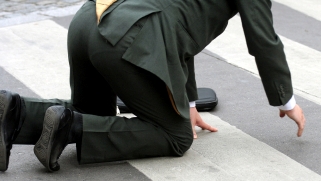 By Barbara Ficarra, RN, BSN, MPA
By Barbara Ficarra, RN, BSN, MPA
You witness an adult collapse to the ground. What do you do? Would you just stand by and watch? Would you call 911??? Would you initiate CPR?
Research reveals that bystanders have been reluctant to perform CPR on a person who drops to the ground because they’re hesitant about putting their mouth on a strangera??s mouth.
Good newsa?|mouth-to-mouth isna??t required
Even without CPR training you can save the life an adult whose heart stops.?? You only need to push hard and fast on the victima??s chest.
Ita??s called a??Hands-Only CPRa?? for the layperson
Push hard and fast in the middle of the victima??s chest, with minimal interruptions.
This recommendation is based on evaluation of recent??scientific studies and consensus of the American Heart Association Emergency Cardiovascular Care (ECC) Committee.
The American Heart Association encourages everyone, trained or not, to act immediately in such an emergency.
Health Professionals
As health professionals, wea??re trained in CPR and performing CPR is something we dona??t even think about.?? We respond automatically if a patienta??s coding in the hospital or if we encounter someone who suddenly collapses on the street or is unconscious.?? Our training is extensive.
For the layperson
For the layperson that has no training, it can be scary to think that all of a sudden you witness someone dropping to the floor and youa??re going to be pushing down hard and fast on their chest.
But think about this
By acting quickly and initiating Hands-Only CPR, the victim who lies motionless,?? could be someonea??s dad, mother, grandpa, grandma, brother, uncle, son, sister, aunt, daughter; someone who has a family to get back to.?? You can help literally save this persona??s life.
While it might be frightening, you can be in charge and initiate Hands-Only CPR right away.?? This person will have a greater chance of surviving because you started CPR before the professionals arrived.
Here are my tips to help you get started, and to help relieve any uncertainty you may have.
- Watch the video from the American Heart Association to help you understand a??Hands-Only CPR.a??
- Check out the clever a??Hands Symphonya???? to see how incredible hands really are
- Check out these useful sites.?? Handsonlycpr and American Heart Association
- For more info, call 877-AHA-4CPR
Now youa??re ready.?? If you witness an adult collapse, act fast, herea??s what you need to do:
Hands-Only CPR
CALL 911 and PUSH HARD AND FAST
- Call 911a??tell someone or call yourself
- Get directly over the victim
- Put the heel of one hand in the center of the chest, then put your other hand on top of the first
- Push hard and fast in the center of the chest until help arrives
- Push at a rate of 100 beats per minute
Side note
The American Heart Association DOES NOT recommend Hands-Only CPR for:
- All infants (up to age 1)
- Children (up to age 8 )
- Adult victims who are found already unconscious and not breathing normally
- Any victims of drowning, drug overdose or collapse due to breathing problems.
Conventional CPR is used.
Bottom Line
Step out of your comfort zone.?? Learn about Hands-Only CPR.?? Ita??s easy to do and you can literally save someonea??s life.?? Youa??ll be the one in charge before professional help arrives.
So remember, call 911 or instruct someone else to call, and push hard and fast in the center of the victima??s chest.
Your Turn
Wea??d love to hear from you.?? Have you ever given CPR to someone who collapsed??? What was your experience like?
Image: iStock Photo

 Now that Google has become a near-universal information provider for many people, it’s finding itself answering questions that need a little more of a nuanced approach.
Now that Google has become a near-universal information provider for many people, it’s finding itself answering questions that need a little more of a nuanced approach. I must say I was surprised (astounded) when I first saw the KFC commercial touting their Buckets for the Cure.??It’s a partnership between KFC and Susan G. Komen for the Cure.??KFC donated 50 cents for each bucket purchased.
I must say I was surprised (astounded) when I first saw the KFC commercial touting their Buckets for the Cure.??It’s a partnership between KFC and Susan G. Komen for the Cure.??KFC donated 50 cents for each bucket purchased.
